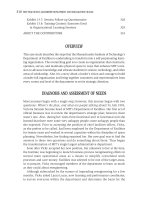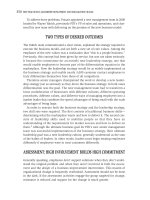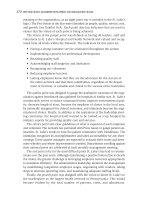Tài liệu Best Practives in Leadership Development & Organization Change 37 pptx
Bạn đang xem bản rút gọn của tài liệu. Xem và tải ngay bản đầy đủ của tài liệu tại đây (151.23 KB, 10 trang )
330
BEST PRACTICES IN LEADERSHIP DEVELOPMENT AND ORGANIZATION CHANGE
Exhibit 13.8. Training Content: Exercises Used in Organizational Learning Sessions (Continued)
Session II
Developing Personal Mastery and Vision
Exercise I—Personal Mastery Exercise
This exercise will help you define your personal vision: what you want to create
for yourself and the world around you. This is one positive way to channel the
stress in your life to more rewarding and fulfilling endeavors.
Your Own Personal Vision: Steps in the Process
Step 1: Knowing what you want your life to be
Create your life plan first by knowing why you are here, often called your mis-
sion. Summarize your mission with using one word—your word-in-the-box. In
other words, what “one word” guides you . . . that you want to strive for.
Your word-in-the-box could be service, excellence, teamwork, peace, happiness,
or anything else . . .
Here’s your very own place for your word-in-the-box:
Step 2: Going deeper with our word-in-the box
Think about your word-in-the box and what that word means to you and your
life’s mission or purpose. Picture that word in three different environments:
• At Home/Your Social Life
• At Work
• Within Yourself
What would you need to change in order to bring forth/incorporate your word
even more in each of these three environments?
_______________________________________________________________________
_______________________________________________________________________
_______________________________________________________________________
_______________________________________________________________________
cart_14399_ch13.qxd 10/19/04 1:15 PM Page 330
MIT
331
Exhibit 13.8. (Continued)
Step 3: Creating a Result (Begin with the end in mind)
Imagine achieving a result in your life that you deeply desire. Begin with the
question, “What do I really want?” Describe the experience you have imagined
by asking these questions: What does it look like? How does it make me feel?
(proud, significant, successful, other feelings . . .)
_______________________________________________________________________
_______________________________________________________________________
_______________________________________________________________________
_______________________________________________________________________
Step 4: Describing Your Personal Vision
You will now want to focus on and get clear about the results you want to see in
your life. Here are some questions to help you in this area:
• What do you want to be doing in three years time that you are not doing today?
_______________________________________________________________________
_______________________________________________________________________
_______________________________________________________________________
_______________________________________________________________________
• What critical skills or “learnings” will you have developed in that time?
_______________________________________________________________________
_______________________________________________________________________
_______________________________________________________________________
_______________________________________________________________________
• What do you want to contribute (or leave behind) as your legacy?
_______________________________________________________________________
_______________________________________________________________________
_______________________________________________________________________
_______________________________________________________________________
• What are some concrete, practical steps that you can take to continue to
develop your personal vision?
_______________________________________________________________________
_______________________________________________________________________
_______________________________________________________________________
_______________________________________________________________________
(Continued)
cart_14399_ch13.qxd 10/19/04 1:15 PM Page 331
332
BEST PRACTICES IN LEADERSHIP DEVELOPMENT AND ORGANIZATION CHANGE
Exhibit 13.8. Training Content: Exercises Used in Organizational Learning Sessions (Continued)
Take yourself forward in time. It is 2005 and your organization/department is
operating in a healthy, productive, and sustainable way.
–What is going on?
–How is it different?
–Why are we going there?
–How are we going to get there?
–What was it you and others did back in 2002 to achieve this remarkable
transformation?
–What creative tensions need to be resolved in order for this change to happen?
Note: This exercise was expanded upon from Session I and highlighted again in Session II to
reflect changes in thinking and to capture new participants.
Exercise III—Ongoing Personal Mastery Exercise: Do Differently
In order to start to initiate any kind of change, it is necessary to first identify
something that you want to change or do differently in your life. You can start
with a goal that you’ve been wanting to initiate, work on some “irritation” or
challenge that you’ve been experiencing, or just do something in a different way
to stretch your creativity.
This exercise involves three steps.
Step 1: Make some change ...dosomething differently . . . start on some goal.
Describe that experience:
_______________________________________________________________________
_______________________________________________________________________
_______________________________________________________________________
_______________________________________________________________________
Step 2: Describe any insights you had from your “do differently.”
_______________________________________________________________________
_______________________________________________________________________
_______________________________________________________________________
_______________________________________________________________________
Step 3: Can you now transfer those insights to a sustained, on-going practice?
_______________________________________________________________________
_______________________________________________________________________
_______________________________________________________________________
_______________________________________________________________________
Source: Copyright
©
Zulauf & Associates, 2001–2002. Reprinted with permission.
References: The Journal of Personal and Professional Success, Vol. 2, Issue 4, and The Fifth Discipline
Fieldbook.
Exercise II—Development of an Organizational Vision
cart_14399_ch13.qxd 10/19/04 1:15 PM Page 332
MIT
333
ABOUT THE CONTRIBUTORS
Joseph Gifun, PE, is assistant director of facilities for infrastructure and special
projects in the Massachusetts Institute of Technology’s Department of Facilities,
where he has worked in various capacities over the past eighteen years. During
the past nine years, Joe’s focus has shifted from engineering to business process
design and organizational learning. He participated in the creation of the Depart-
ment of Facilities’ strategic plan and led the design and implementation of the
department’s repair and maintenance reengineering effort and co-managed
the resultant process. He developed and implemented MIT’s infrastructure
renewal program and led it from its inception. Joe is a registered professional
engineer in the Commonwealth of Massachusetts and he holds a Bachelor of
Science degree in civil engineering from Lowell Technological Institute and a
Master’s degree in adult and organizational learning from Suffolk University.
Patricia Kennedy Graham is director of administration for the Massachusetts
Institute of Technology’s Department of Facilities. In that capacity, Pat has respon-
sibility for the human resource, learning and performance, and IT teams that
support the entire department. Additionally, she participates as a member of the
operational leadership team, the strategic leadership team, and the director’s
team for the department. Pat worked at MIT’s Lincoln Laboratory, a federally
funded research and development center, as associate group leader. Pat left
Lincoln Laboratory to be the director of administration for the Boston office of
Deloitte & Touche. Prior to returning to MIT to work in the Department of Facil-
ities, she was managing director at Surgency, Inc., a management consulting firm
specializing in best business practices and e-business transformation consulting.
Pat received her Bachelor of Arts degree from Boston College and Master’s degree
in administration from Boston University.
Dr. Carol Ann Zulauf is associate professor of adult and organizational learning
at Suffolk University in Boston. She also has her own consulting practice,
specializing in leadership, team development, and systems thinking. Her clients
span high-tech, federal and state government, health care, education, and
consumer product organizations. Her prior work experience includes being a
senior training instructor for Motorola, Inc. Dr. Zulauf has many publications
to her credit, including her newly published book, The Big Picture: A Systems
Thinking Story for Managers (Linkage Press, 2001). She is also a frequent
presenter at regional, national, and international conferences.
cart_14399_ch13.qxd 10/19/04 1:15 PM Page 333
334
CHAPTER FOURTEEN
Motorola
This case study describes Motorola’s success in quickly acquiring, developing,
and leveraging the world-class leadership talent it needed to turn around the
company’s performance and accelerate its return to prominence in the world
market through talent management, recruitment and selection procedures,
career planning and development, linkage of performance to rewards,
assistance in transition, and clear standards for leadership.
OVERVIEW 335
THE DEMAND SIDE 335
THE SUPPLY SIDE 336
LEADERSHIP SUPPLY IS A CORE BUSINESS PRINCIPLE 337
THE NEW MOTOROLA LEADERSHIP SUPPLY PROCESS 337
Recruit and Select 337
Performance Management 338
TALENT MANAGEMENT 338
Career Planning and Development 338
Rewards 338
TRANSITION ASSISTANCE 338
PERFORMANCE MANAGEMENT IS KEY 339
Leadership Standards 339
Motorola’s Performance Management Process 340
Link to Rewards 341
SO WHAT? 342
LESSONS LEARNED AND “DO DIFFERENTLIES” 342
REFERENCES 344
ABOUT THE CONTRIBUTORS 344
S
S
cart_14399_ch14.qxd 10/19/04 1:16 PM Page 334









